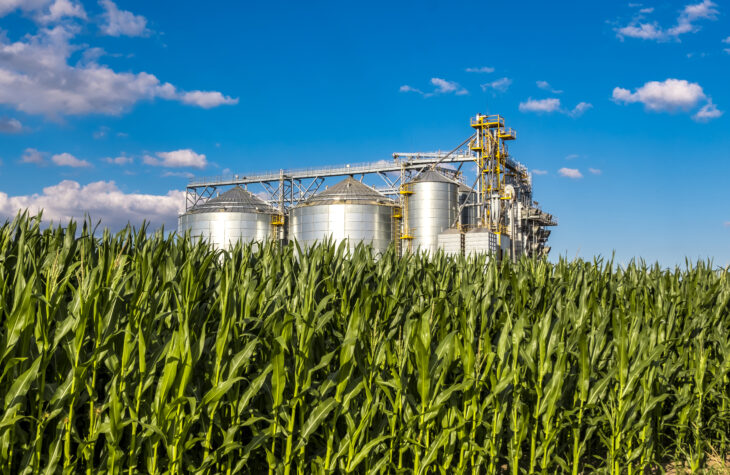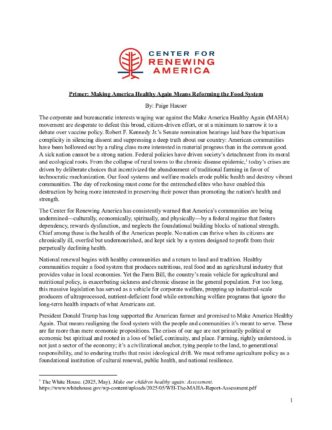
Primer: Making America Healthy Again Means Reforming the Food System
The corporate and bureaucratic interests waging war against the Make America Healthy Again (MAHA) movement are desperate to defeat this broad, citizen-driven effort, or at a minimum to narrow it to a debate over vaccine policy. Robert F. Kennedy Jr.’s Senate nomination hearings laid bare the bipartisan complicity in silencing dissent and suppressing a deep truth about our country: American communities have been hollowed out by a ruling class more interested in material progress than in the common good. A sick nation cannot be a strong nation. Federal policies have driven society’s detachment from its moral and ecological roots. From the collapse of rural towns to the chronic disease epidemic,1 today’s crises are driven by deliberate choices that incentivized the abandonment of traditional farming in favor of technocratic mechanization. Our food systems and welfare models erode public health and destroy vibrant communities. The day of reckoning must come for the entrenched elites who have enabled this destruction by being more interested in preserving their power than promoting the nation’s health and strength.
The Center for Renewing America has consistently warned that America’s communities are being undermined—culturally, economically, spiritually, and physically—by a federal regime that fosters dependency, rewards dysfunction, and neglects the foundational building blocks of national strength. Chief among these is the health of the American people. No nation can thrive when its citizens are chronically ill, overfed but undernourished, and kept sick by a system designed to profit from their perpetually declining health.
National renewal begins with healthy communities and a return to land and tradition. Healthy communities require a food system that produces nutritious, real food and an agricultural industry that provides value in local economies. Yet the Farm Bill, the country’s main vehicle for agricultural and nutritional policy, is exacerbating sickness and chronic disease in the general population. For too long, this massive legislation has served as a vehicle for corporate welfare, propping up industrial-scale producers of ultraprocessed, nutrient-deficient food while entrenching welfare programs that ignore the long-term health impacts of what Americans eat.
President Donald Trump has long supported the American farmer and promised to Make America Healthy Again. That means realigning the food system with the people and communities it’s meant to serve. These are far more than mere economic propositions. The crises of our age are not primarily political or economic but spiritual and rooted in a loss of belief, continuity, and place. Farming, rightly understood, is not just a sector of the economy; it’s a civilizational anchor, tying people to the land, to generational responsibility, and to enduring truths that resist ideological drift. We must reframe agriculture policy as a foundational institution of cultural renewal, public health, and national resilience.
This is a call not to austerity, nostalgia, or sentimentality but to a more fruitful and abundant life for all Americans, rooted in stewardship of the land rather than extraction and in community rather than consumption.2 In the rhythms of the farm is a model for human flourishing. True abundance is not measured solely by yield but by the strength of families, the health of the soil, the resilience of communities, and the moral formation that comes from working with, not against, the land. Public policy should reflect this richer vision by supporting local food systems, regenerative practices, and cultural traditions that make abundance both possible and meaningful, but this is exactly what the current system discourages. The upcoming reauthorization of the Farm Bill presents an opportunity to reassess policy and restore what the industrial age and post–New Deal welfare apparatus have stripped away: the nonmaterial goods of community, character, and responsibility.
The Cost of the Current System
America is quietly losing its agricultural backbone. Between 2017 and 2024, the United States lost an average of approximately 22,857 farms per year, which is just one part of a broader trend of consolidation in agriculture. During this period, the total number of U.S. farms fell from 2.04 million to 1.88 million.3 These aren’t just numbers; they represent multigenerational family farmers and ranchers, stewards of the land, defenders of the American way of life, and the producers feeding their neighbors and local communities. Yet, while these small operations disappear, there has been a 40 percent increase in the total value of agricultural production, which rose from $389 billion in 2017 to $543 billion in 2022.4
This so-called “growth” is not rooted in greater food security or crop diversity but in the consolidation of farmland into the hands of fewer, larger operators. These industrial-scale operations focus overwhelmingly on growing corn and soybeans, which are further processed to feed factory-farmed livestock and other derivative products. Nearly three-quarters of U.S. farmland is now dedicated to either beef cattle (40 percent) or grain and oilseed production (32 percent).5 This transformation threatens not just the livelihoods of American farmers but the resilience, health, and sovereignty of the entire country.
Americans sense this decline intuitively, not because of a lack of talent or technology but because the very systems meant to nourish and sustain them are contributing to their ruin. Rates of obesity, type 2 diabetes, cardiovascular disease, and even infertility are skyrocketing. Nearly 60 percent of adults now live with chronic diseases,6 and over 40 percent are clinically obese.7 A shocking one in three children is obese,8 and one in four teens has type 2 diabetes or prediabetes.9 Health care costs $3.7 trillion a year, and 80 percent of that amount goes to preventable chronic disease care.10 As recently as the 1960s, American household budgets allocated approximately 17.5 percent of disposable income to food and about 4 percent to health care. By 2023, food spending had declined to 10.8 percent of disposable income, and health care had risen to 17.6 percent of GDP.11 Food is getting cheaper, but Americans are getting sicker. These trends are not accidental; they are the direct result of a food and agriculture system incentivized by federal policy to prioritize quantity over quality, shelf stability over nutrition, and corporate profit over public health.
This is not just a health crisis. It is a national security threat and a profound cultural and demographic crisis. It is no exaggeration to say that a crisis of national readiness is upon us. Nearly 77 percent of young Americans are now unfit for military service, primarily due to obesity and related health conditions. At the same time, chronic disease, not combat injury, has emerged as the leading cause of early military retirement, which means that the military has systematically failed to maintain the long-term health of our service members and, therefore, troop readiness.12
A chronically ill population is less productive, less fertile, more dependent on public assistance, and increasingly disconnected from the civic and economic life of communities. As the Center for Renewing America has noted elsewhere, the national fertility rate has plummeted to just 1.6 children per woman, and infertility now affects nearly one in eight couples, which is evidence of both biological and societal decline.13 Simultaneously, civic life is eroding as fewer Americans participate in community institutions, and government transfer payments now make up nearly one-fifth of all personal income.14 These trends reflect economic hardship and a loss of purpose and resilience at the heart of American life.
The Broken System
The Farm Bill—spanning nearly $1.5 trillion over a decade—has played a central role in creating this broken system. What began as a safety net for farmers and a way to ensure a stable food supply has morphed into a sprawling apparatus that fuels industrial overproduction of commodity crops like wheat, corn, and soy, which are the feedstock for ultraprocessed foods, cheap sweeteners, hydrogenated oils, and feed for confined animal operations.15 In 2016, nearly 90 percent of U.S. farms were small family operations, but they received just 27 percent of commodity payments and a mere 17 percent of crop insurance indemnities. Meanwhile, commercial farms, which make up just over 1 percent of all farms, gobbled up 73 percent of those same subsidies and 83 percent of indemnities. Worse, large-scale family farms, which make up only 2.9 percent of all farms, claimed 35 percent of commodity payments and nearly half of all crop insurance payouts.16 This gross imbalance is the result of a system that rewards size.

These subsidies have made their derivative products disproportionately affordable and accessible. From 1982 to 2008, the cost of processed, grain-derived products plummeted: down 10 percent for fats and oils, 15 percent for sugars and sweets, and 34 percent for carbonated beverages. Meanwhile, fresh fruits and vegetables rose in price by 50 percent.17 This market distortion, driven by federal subsidies and policy choices, has prioritized cheap, calorie-dense products over nutritious, whole foods. Meanwhile, smaller sustainable farming practices, which offer healthier, more nutritious foods, are squeezed out of the market.
Just four multinational firms—Archer Daniels Midland (ADM), Bunge, Cargill, and Louis Dreyfus—control the vast majority of grain trade and infrastructure, dictating terms to American farmers.18 Meanwhile, two corporations—Bayer and Corteva—control over 90 percent of U.S. corn and soybean seed sales, locking producers into high-cost, vertically integrated input systems.19
The companies that dominate America’s food and farm systems are not farmers in any traditional sense of the word; they are global financial operations that masquerade as farmers when it benefits them. Cargill, the largest private company in the United States, is controlled by one of the richest families in the world. ADM, Bunge, Bayer, and Corteva are all publicly traded companies, with major ownership stakes held by prominent Wall Street investors such as BlackRock and Vanguard. Louis Dreyfus, meanwhile, is partially owned by a foreign sovereign wealth fund from Abu Dhabi.20 These are not stewards of the land or defenders of rural America; they are multinational conglomerates. And this consolidation has been bad for American farmers. Today, farmers receive just 15 cents of every food dollar, down from 53 cents in 1946, the lowest share ever recorded.21
Meanwhile, the largest portion of the Farm Bill, nutrition assistance programs such as the Supplemental Nutrition Assistance Program (SNAP, or food stamps), remains largely disconnected from actual nutrition. These programs funnel billions of taxpayer dollars into the purchase of highly processed, calorie-dense but nutrient-poor products, further enriching the very corporations whose business models depend on keeping America sick. SNAP pays about $7 billion a year for thirty-one billion servings of soda. It is the biggest line item in the SNAP program, accounting for about 10 percent of the “food” purchased on it. SNAP accounts for 20 percent of U.S. revenue for Coca-Cola.22
Corn is a good case study for how the system works—or does not work, depending on one’s frame of reference. First, taxpayers subsidize the growing of corn at a cost of about $250 million a year. Hardly any of that corn is consumed as corn on the cob; instead, 8 percent is made into high-fructose corn syrup, and most of the rest becomes feed for concentrated animal feeding operations (CAFOs) or turned into ethanol, cooking oil, alcohol, and other industrial products or food additives. Then the taxpayer subsidizes the consumption of food and drink made from corn syrup at about $75 billion a year from just SNAP (75 percent of the foods purchased with SNAP are ultraprocessed). Next comes billions of dollars in advertising costs that food companies can deduct from their taxes.23 On top of that are the health-care costs associated with chronic disease from consumption of large amounts of ultraprocessed foods, which are substantial given that the federal government pays for the health care of more than half of the U.S. population.24
The libertarian defense that personal responsibility is the way to prevent these chronic diseases is inadequate to respond to these realities. It is absurd for elites with significant disposable income and a Whole Foods Market down the block to lecture working-class Americans on “personal responsibility” in their grocery choices. The real irresponsibility lies with the political class that subsidizes junk food, empowers corporate monopolies, and then blames struggling families for eating what the system makes cheap and available.
Beyond SNAP, federal policy also heavily subsidizes ultraprocessed food in the National School Lunch Program (NSLP). In the 2018–2019 school year, NSLP spent about $18.7 billion reimbursing schools and purchasing U.S. Department of Agriculture (USDA) commodities for school meals served to eligible students. Those meals must comply with nutritional standards based on the Dietary Guidelines for Americans established by the USDA. While specific data on the exact percentage of the NSLP budget allocated to ultraprocessed foods is limited, several factors indicate that ultraprocessed and prepackaged items constitute a significant portion of school meals. Kraft Heinz’s Lunchables—ultraprocessed, sodium-loaded snack kits—were approved for school lunches by the USDA. Frozen pizza qualifies as a vegetable because of a smear of tomato paste, and half of the vegetables eaten by children in the NSLP are French fries.
The Farm Bill’s policies have turbocharged the centralization of the food system. Over the past half century, federal incentives have driven rapid consolidation in farming, food processing, and distribution. Small farms and local processors have been squeezed out by vertically integrated, multinational conglomerates, often under the banner of “efficiency.” The result is a brittle system vulnerable to disruption, controlled by a handful of players, and designed to serve shareholders, not communities.
Principles for Reform
The urgent task before Congress is not to merely tweak the Farm Bill but to fundamentally realign its priorities toward those that promote the health, strength, and independence of the American people. The Farm Bill has operated on a technocratic logic, optimizing yield and efficiency at the expense of everything else. The result is a food system that is highly productive but profoundly unhealthy, economically extractive, and socially corrosive. Consistent with President Trump’s promise to Make America Healthy Again, the guiding principles for reform must be rooted in the dignity of citizens, both consumers and producers, farmers and ranchers; the strength of the local community; and the long-term health of the nation.
1. Health First
The foundational failure of the current system is its refusal to prioritize health as a policy objective. Today, over 60 percent of the calories consumed by Americans come from ultraprocessed foods, which are strongly linked to high rates of obesity, heart disease, and cancer.25 This was nowhere near the case fifty years ago. Food is not just an economic commodity; it is a pillar of national well-being. Reform must begin with the principle that taxpayer dollars, whether spent on agriculture subsidies or nutrition assistance, should support the physical health of the American people. That means reorienting policy to promote nutrient-dense, whole foods rather than ultraprocessed products designed for shelf life and profit margin.
2. Local Resilience over Centralized Control
A centralized food system may be efficient on paper, but it is dangerously fragile in practice. Yet, that is the system we have, a dangerously weak system that claims to be feeding the world. In 2020, just four companies controlled over 85 percent of beef processing in the United States, a situation that creates dangerous bottlenecks when even one facility shuts down due to animal illness or supply chain stress.26 One of them, JBS, is a foreign-owned company headquartered in Brazil. In less than two decades, JBS grew from a modest operation into a global behemoth that slaughters over 76,000 cattle, 127,000 hogs, and nearly 14 million birds per day. By 2021, it was outselling giant food corporations such as Nestlé and PepsiCo.27 Few Americans know they are buying from a foreign company when they purchase JBS’s products because the company obfuscates its control over the market by maintaining forty-three brands (as of 2023) for the products it sells in the United States.28
Since about 1980, America has lost 50 percent of its cattle farms, 80 percent of its dairies, and 90 percent of its hog farms. These have been replaced with CAFOs. The largest owner and slaughterer of pigs in America is a Chinese company named WH Group.29 This isn’t competition; it’s foreign commercial conquest. Letting a foreign-backed titan dominate America’s meat supply is a direct threat to food sovereignty, rural livelihoods, and national security.
During the COVID-19 pandemic, supply chain disruptions exposed the brittleness of a model that outsources food production and concentrates processing in a handful of corporate-controlled and often foreign-owned facilities. Real resilience requires local and regional diversity of producers, processors, distributors, and retailers. When food is grown, processed, and consumed closer to home, communities are stronger, jobs are local, and shocks are easier to absorb. A decentralized system also allows for more accountability, better stewardship of land, and more responsive innovation. For small and medium-sized farms to have a chance of competing, the incentives that gave rise to the oligopoly need to be reformed.
3. Regeneration over Extraction
For decades, federal policy has incentivized extractive agriculture, monoculture, and monocropping,30 which deplete soil, pollute water, and require ever more chemical inputs just to maintain yields. As a result of this process, the United States is losing nearly 5.6 tons of topsoil per acre each year, primarily due to industrial agriculture practices, placing long-term food security at risk.31 This benefits chemical companies and Wall Street investors but leaves rural America drained and degraded. Reforming the Farm Bill requires a shift of incentives away from centralized industrial practice that favors Big Ag and toward regenerative practices that build soil health, restore ecological balance, and support long-term productivity.
Promoting regenerative farming practices would signify a return to American heritage. Many already doing excellent work in this space are concerned about the climate, but one need not sign on to radical climate dogma to embrace these policy reforms. These reforms are about common-sense conservation, which is fundamentally conservative and can unite farmers, families, and policymakers from across the political spectrum. Healthy soil is the foundation for healthy food, clean water, and economic resilience.
Reforming the Farm Bill
Reforming Subsidies: The current Farm Bill steers billions of dollars toward the production of commodity crops such as corn and soy, much of which are not consumed directly but transformed into the cheap sweeteners and oils. Thus these heavily subsidized crops become the ultraprocessed foods that dominate grocery shelves and school lunches. Taxpayer support for these supply chains must be cut off. If taxpayer dollars are to be spent on these commodity crops, they should be directed toward foods that support human health and rebuild communities. That means prioritizing diversified agricultural products such as fruits and vegetables, which the USDA terms “specialty crops.” It means helping existing conventional farms convert to regenerative practices, which the data suggest is economically more viable than current agricultural practices.
The next Farm Bill must confront the rigged subsidy system that favors the largest, most entrenched producers at the expense of independent farmers and the American taxpayer. Congress should cap commodity payments to high-grossing operations, eliminate outdated base acreage entitlements that block new and small producers, and restore fiscal discipline by requiring farms to choose between taxpayer-backed crop insurance or commodity supports. Finally, it’s time to phase out single-crop payments that fuel monoculture and market distortion.
Currently, federal subsidies reward large-scale conventional operations reliant on chemical inputs rather than farming methods that restore ecological function. Farmers who use regenerative practices such as crop rotation, cover cropping, rotational grazing, and composting, which build soil fertility, reduce runoff, and increase resilience to drought and disease, must be able to access support programs on an equal playing field with the big industrial producers. This is especially important because regenerative practices improve food quality, support long-term productivity, and create opportunities for young and independent farmers. Crucially, this approach must sidestep divisive climate rhetoric, focusing instead on unifying goals: fertile soil, clean water, vibrant rural economies, and nutritious real food.
Working with the way nature was designed to operate requires fewer inputs and yields higher returns. One study found that a shift from conventional to regenerative agriculture could yield a 15 to 25 percent return on investment, with a 50 percent decrease in fertilizer use and up to a 75 percent reduction in pesticide application and enhanced soil health, leading to more resilient crop yields.32 McKinsey examined corn and soybean farms and found that by simply implementing regenerative practices such as no-till farming and cover cropping on 80 percent of their acreage, farmers could generate up to $250 billion in economic value over a decade. This would include potential annual returns of $20 to $60 per acre, improved yields, and increased land value, especially in regions with variable weather patterns.33 Reform in this area would mean incentivizing practices that restore depleted soils rather than further degrading them.
Deregulating Agricultural Environments: The Farm Bill should dismantle regulatory barriers under the Clean Water Act (CWA), Endangered Species Act (ESA), and Food Safety Modernization Act (FSMA) to empower small farms. By expanding CWA exemptions for routine farming and clarifying the definition of Waters of the United States (WOTUS) to exclude ephemeral streams, small farmers would save thousands in annual compliance costs. Rescinding the ESA’s “harm” definition and streamlining Habitat Conservation Plans would reduce consultation costs, freeing resources for regenerative practices. Expanding FSMA exemptions to farms that make under a certain amount in sales and/or establishing direct-to-consumer exemptions and simplifying meat inspection would also allow smaller farms to compete with large firms.
Reforming Nutrition Assistance to Align with Health: Nutrition assistance programs such as SNAP make up the largest share of Farm Bill spending: over $100 billion annually. Yet these funds are too often spent on ultraprocessed foods, with studies showing that sugary beverages are among the top SNAP purchases. Reform is urgently needed to ensure these programs do not subsidize chronic illness. Several states are pursuing federal waivers to prohibit the use of SNAP benefits for purchasing ultraprocessed junk foods,34 and some have already been approved, including for Nebraska, Iowa, Indiana, Arkansas, Idaho, and Utah.35 The Farm Bill should make these types of reforms permanent.
Redirecting Purchases toward Regenerative Agriculture: The federal government is a major buyer of food, spending approximately $7.7 billion in FY 2023 across various agencies, including the Department of Defense (DOD) and the USDA. Of this total, DOD accounted for $2.4 billion, representing about 31 percent of federal food purchases.36 Much of this spending, however, supports the same industrial food system that undermines American farmers and rural communities. The Farm Bill could amend USDA’s procurement guidelines under the National School Lunch Program and the Federal Acquisition Regulations to prioritize bids from local farms or those with regenerative practices. Similar preferences could be applied to federal contracts or a set-aside requiring a certain percentage of food purchases to come from local farms with less than around $1 million in gross income. In this way, taxpayer dollars could be redirected to support regenerative agriculture. Leveraging federal purchasing power in this way would benefit both producers and consumers. Other large institutional buyers such as hospitals, universities, and corporate campuses also could play a pivotal role by sourcing from regenerative farms.
Incentivizing Decentralization and Local Infrastructure: The federal government has spent decades consolidating the food system in the name of efficiency, shuttering small processors, closing local distribution hubs, and favoring vertically integrated large agricultural firms. It’s time to reverse course. A revitalized Farm Bill would refocus funding on local infrastructure such as regional meat processors, grain mills, food hubs, and cooperatives, and break down the regulatory and financial barriers that prevent smaller operations from competing. Decentralization is not a solution rooted in nostalgia; it is a practical strategy for national resilience, economic opportunity, and stronger community ties.
The Farm Bill could better support regional meat processing by removing the requirement that all meat sold commercially must be processed in a USDA-inspected slaughterhouse.37 These federal facilities are expensive to build and operate and are increasingly scarce, especially in rural areas, due to decades of consolidation in the meat-packing industry. As a result, small farmers often must transport animals hundreds of miles to the nearest USDA plant, incurring high costs and long wait times, or forgo selling meat altogether. Removing the federal requirement would allow the sale of meat processed at custom slaughterhouses, which are regularly inspected but not USDA-certified, for sale within a state. This policy would remove a major federal barrier to entry for independent producers, support regional food systems, and reduce reliance on corporate giants such as JBS, Tyson, and Cargill, which currently dominate over 80 percent of the U.S. meat market.
The Center for Renewing America has previously warned of Chinese ambitions to gain greater dominance over domestic and global supply chains in order to wield food as a weapon of economic warfare against the United States.38 Foreign acquisition of American agricultural land now totals over 45.85 million acres, or 3.6 percent of all privately held farmland.39 This acquisition raises serious concerns about food security, national sovereignty, and strategic vulnerability. While Chinese investors currently hold only a fraction of this land (roughly 277,336 acres),40 these purchases’ nature and location (often near sensitive military sites) underscore the risks posed by adversarial interests gaining footholds within our borders. There is an urgent need to defend the integrity of America’s land and food systems by strengthening oversight mechanisms and expanding the jurisdiction and authority of the Committee on Foreign Investment in the United States. President Trump did this recently in his National Security Presidential Memorandum.41 Congress should consider codifying this policy in the next Farm Bill. Prudent steps have also been taken at the state level: Twenty-six states have enacted laws to limit foreign ownership of agricultural land.42 Beyond limiting foreign influence, a reformed Farm Bill must prioritize policies that restore land access to American citizens. This includes implementing loan guarantees and targeted subsidies to support domestic land acquisition, particularly for young farmers and local cooperatives.
There are other avenues the federal government should explore to transition the food system as well. The Trump administration announced that it would free up federal land for housing development. This is a worthy endeavor given the lack of affordable housing in many localities. But the majority of the available federal land holdings are in the western half of the country, and only about 250 million acres are available for grazing.43 Decentralizing control over grazing permits and expanding access to small-scale ranchers would allow for more innovation, flexibility, and long-term stewardship of federal lands. Empowering communities in this way could revitalize rural economies, increase food sovereignty, and reduce the influence of corporate agribusiness on the American food supply.
Opening more federal land to grazing could also reduce the burden on taxpayers by creating more productive uses for land and reducing the costs associated with maintaining unused public lands. A model of cooperative stewardship would ensure that public lands benefit both the environment and local communities while promoting a more decentralized, locally driven agricultural economy. The Trump administration might consider opening federal lands for regenerative farming and ranching operations as a twenty-first-century version of the Homestead Act.
The Farm Bill should remove as many barriers to entry for new farmers interested in regenerative practices as possible. After all, land is expensive, so solutions must be found to help new farmers acquire property. Another way to reduce costs and lower risks associated with farming would be to expand tax-exempt financing to low-interest bonds.
Finally, the president has taken the once-in-a-generation opportunity to rebalance global trade to bring manufacturing back to the United States. Growing and producing food domestically should be included in those efforts. In 2019, for the first time in over fifty years, the United States ran an agricultural trade deficit; this trend has continued in five of the last seven years, and the trade deficit is projected to reach a record $49 billion in 2025.44 This growing imbalance is driven largely by a sharp rise in fruit and vegetable imports, particularly from Mexico, where import values grew from $15.7 billion in 2019 to $21 billion in 2023. Imports now make up the majority of the U.S. supply of key crops like tomatoes (69 percent), cucumbers (89 percent), and bell peppers (74 percent) while American farmers are losing their livelihoods and local supply chains are deteriorating.45 Fruits and vegetables receive less government support than commodity crops do, but they are significantly more valuable to the health and well-being of Americans and require less land to be profitable. A modest shift of just 270,000 acres from corn and soy to vegetables could generate $882 million in farm sales and $3.3 billion in retail value while supporting new farmers and reducing trade dependence.46 To rebalance trade effectively, agriculture must be part of the national strategy.
Conclusion
The Farm Bill is the primary vehicle for setting national food policy, so reforming it is of vital importance. A realigned Farm Bill will help make America healthy again by addressing the root causes of chronic disease, restoring community life through local food economies, and strengthening national security with resilient supply chains and a fit, self-reliant citizenry. It will also deliver fiscal benefits: a less bloated bill that no longer subsidizes sickness and waste and a public health dividend through lower health-care costs driven by improved diets and stronger communities. In short, smarter food policy means a stronger, healthier, and more sovereign America.
Endnotes
1. The White House. (2025, May). Make our children healthy again: Assessment. https://www.whitehouse.gov/wp-content/uploads/2025/05/WH-The-MAHA-Report-Assessment.pdf
2. Community here means a rooted way of life that is grounded in a particular place, history, and responsibility to it. It stands in contrast to the rootlessness of a consumer culture that prizes convenience and price above all else. In community, there is a sense of responsibility and participation in which one declares, “I am part of this.” In consumption, there are merely detached transactions, in which one asks, “What can I get from this?”
3. U.S. Department of Agriculture, Economic Research Service. (2024). Number of U.S. farms continues slow decline [Chart]. https://www.ers.usda.gov/data-products/chart-gallery/chart-detail/?chartId=58268
4. U.S. Department of Agriculture. (2024, February 13). 2022 Census of Agriculture: Highlights. https://www.ers.usda.gov/data-products/charts-of-note/chart-detail/?chartId=108629
5. ProFarmer. (2024, February 13). USDA releases 2022 Census of Agriculture data. https://www.profarmer.com/news/agriculture-news/usda-releases-2022-census-agriculture-data
6. Centers for Disease Control and Prevention. (2021). National Health Interview Survey, 2019–2020: Summary health statistics. U.S. Department of Health and Human Services. https://www.cdc.gov/nchs/nhis/index.htm
7. Centers for Disease Control and Prevention. (2024). National Health and Nutrition Examination Survey, August 2021–August 2023: Obesity prevalence among adults. U.S. Department of Health and Human Services. https://www.cdc.gov/nchs/nhanes/index.htm
8. Centers for Disease Control and Prevention. (2020). National Health and Nutrition Examination Survey, 2017–2018: Childhood obesity and overweight prevalence. U.S. Department of Health and Human Services. https://www.cdc.gov/nchs/nhanes/index.htm
9. Andes, L. J., Cheng, Y. J., Rolka, D. B., Gregg, E. W., & Imperatore, G. (2020). Prevalence of prediabetes among adolescents and young adults in the United States, 2015–2018. JAMA Pediatrics, 174(2), e194498. https://doi.org/10.1001/jamapediatrics.2019.4498
10. FoodFix. (n.d.). Fixing the broken food system. Retrieved April 24, 2025, from https://cdn.prod.website-files.com/619d3f80678e550687706074/62571c2dafc9bcfd462a6fb5_FoodFix_BrokenFoodSystem.pdf
11. Centers for Medicare & Medicaid Services. (2023). National health expenditure data: NHE fact sheet. https://www.cms.gov/data-research/statistics-trends-and-reports/national-health-expenditure-data/nhe-fact-sheet; U.S. Department of Agriculture, Economic Research Service. (2023). Food prices and spending. https://www.ers.usda.gov/data-products/ag-and-food-statistics-charting-the-essentials/food-prices-and-spending/
12. Centers for Disease Control and Prevention. (2023). Unfit to serve: Obesity and physical inactivity jeopardize national security. https://www.cdc.gov/physicalactivity/resources/unfit-to-serve/; A-Mark Foundation. (2022). Is obesity a threat to national security? https://amarkfoundation.org/reports/is-obesity-a-threat-to-national-security/; The Epoch Times. (2023, February 15). Almost 80 percent of Americans aged 17–24 unfit for military service. https://www.theepochtimes.com/us/food-assistance-contributing-to-obesity-with-almost-80-percent-of-americans-aged-17-24-unfit-for-military-service-5076107
13. Hauser, P. (2025, April 11). Primer: Family formation in America’s new golden age. Center for Renewing America. https://americarenewing.com/issues/primer-family-formation-in-americas-new-golden-age/
14. Economic Innovation Group. (2024). Americans grow increasingly dependent on government payments. Reason. https://reason.com/2024/10/04/americans-grow-increasingly-dependent-on-government-payments/; Business Insider. (2024). 2 maps show that Americans rely on income like Social Security more than they used to. https://www.businessinsider.com/social-security-medicaid-snap-benefits-income-reliance-increases-aging-population-2024-11; Time. (2024). The myth of opportunity has broken America. https://time.com/7208831/america-trump-myth-of-opportunity-essay/; Survey Center on American Life. (2024). Disconnected: The growing class divide in American civic life. https://www.americansurveycenter.org/research/disconnected-places-and-spaces/; Centers for Disease Control and Prevention. (2024). Unfit to serve: Obesity and physical inactivity jeopardize national security. https://www.cdc.gov/physicalactivity/resources/unfit-to-serve/; Centers for Disease Control and Prevention. (2024). Infertility. https://www.cdc.gov/nchs/fastats/infertility.htm/
15. Bakst, D. (2018, April 16). What you should know about who receives farm subsidies. The Heritage Foundation. https://www.heritage.org/agriculture/report/what-you-should-know-about-who-receives-farm-subsidies
16. Ibid.
17. Frerick, A. (2024). Barons: Money, power, and the corruption of America’s food industry. Island Press. p. 46
18. Ibid.
19. Howard, P. H. (2021). Concentration and Power in the Food System: Who Controls What We Eat? (2nd ed.). Bloomsbury Academic
20. Cargill. (n.d.). Company overview. https://www.cargill.com/about; Archer Daniels Midland (ADM). (2024). Investor relations. https://investors.adm.com; Bunge Limited. (2024). Investor relations. https://investors.bunge.com; Louis Dreyfus Company. (2021). ADQ acquires 45% equity stake in Louis Dreyfus Company. https://www.ldc.com; Bayer AG. (2024). Investor information. https://www.investor.bayer.com; Corteva Agriscience. (2024). Investor relations. https://investors.corteva.com
21. Frerick (2024). p. 43
22. Hyman, M. (2020). Food fix: How to save our health, our economy, our communities, and our planet—one bite at a time. Little, Brown Spark. pp. 33–34.
23. Statista. (n.d.). Local advertising spending of the food & restaurant industry in the U.S. Retrieved June 17, 2025, from https://www.statista.com/statistics/1560441/local-advertising-spending-food-restaurant-industry-us/
24. Ibid.
25. Monteiro, C. A., Moubarac, J.-C., Cannon, G., Ng, S. W., & Popkin, B. (2023). Ultra-processed products are becoming dominant in the global food system. BMJ Global Health 8(1), e010385. https://doi.org/10.1136/bmjgh-2023-010385
26. U.S. Department of Agriculture. (2021). Concentration in the U.S. Meat Processing Industry. Economic Research Service. https://www.ers.usda.gov/
27. Frerick (2024). p. 118
28. Ibid., p. 120
29. Frerick, A., & Mitchell, C. (2020, April 21). Multinational meat farms could be making us sick. The American Conservative. https://www.theamericanconservative.com/multinational-meat-companies-could-be-making-us-sick/
30. While often used interchangeably, monocrop refers to the practice of planting a single crop in a given area during one season, whereas monoculture describes a broader agricultural system in which the same crop or type of crop dominates year after year, often across entire regions. Monoculture is particularly concerning because it depletes soil health, undermines ecological resilience, and concentrates economic and biological risk.
31. Natural Resources Conservation Service. (2018). Soil Health: The Importance of Protecting Our Topsoil. United States Department of Agriculture. https://www.nrcs.usda.gov/
32. Bugas, J., Conant, H., Hoo, S., Bellino, F., Unnikrishnan, S., & Westerlund, M. (2023, August 15). Regenerative agriculture’s profitability for U.S. farmers. Boston Consulting Group. https://www.bcg.com/publications/2023/regenerative-agriculture-profitability-us-farmers
33. McKinsey & Company. (2024, April 9). Revitalizing fields through regenerative agriculture practices. https://www.mckinsey.org/industries/agriculture/our-insights/revitalizing-fields-and-balance-sheets-through-regenerative-farming
34. Douglas, L. (2025, June 10). US farm agency to allow three more states to bar some items from food aid. Reuters. Retrieved June 17, 2025, from https://www.reuters.com/business/healthcare-pharmaceuticals/us-farm-agency-allow-three-more-states-bar-some-items-food-aid-2025-06-10/
35. U.S. Department of Agriculture. (2025, June 10). Secretary Rollins signs state waivers to “Make America Healthy Again,” removing unhealthy foods from SNAP [Press release]. U.S. Department of Agriculture. Retrieved June 17, 2025, from https://www.usda.gov/about-usda/news/press-releases/2025/06/10/secretary-rollins-signs-state-waivers-make-america-healthy-again-removing-unhealthy-foods-snap
36. Congressional Research Service. (2023, July 10). Federal food procurement: USDA, DOD, and other agency purchases (CRS Report No. R48141). https://crsreports.congress.gov/product/pdf/R/R48141
37. Massie, T. (2023, April 26). Representatives Massie and Pingree introduce bipartisan PRIME Act to empower local livestock farmers, meet consumer demand. U.S. House of Representatives. https://massie.house.gov/news/documentsingle.aspx?DocumentID=395537
38. CRA Staff. (2023, October 2). Primer: The Farm Bill and protecting American agriculture. https://americarenewing.com/issues/primer-the-farm-bill-and-protecting-american-agriculture/
39. U.S. Department of Agriculture, Farm Service Agency. (2024, December). Foreign holdings of U.S. agricultural land through December 31, 2023. https://www.fsa.usda.gov/sites/default/files/2024-12/AFIDAYR2023ReportwithPageNumbers.pdf
40. Ibid.
41. The White House. (2025, February 21). Fact sheet: President Donald J. Trump encourages foreign investment while protecting national security. https://www.whitehouse.gov/fact-sheets/2025/02/fact-sheet-president-donald-j-trump-encourages-foreign-investment-while-protecting-national-security/
42. National Agricultural Law Center. (n.d.). Foreign investments in agriculture. https://nationalaglawcenter.org/foreign-investments-in-ag/
43. Vincent, C. H., Hanson, L. A., & Argueta, C. N. (2020, February 21). Federal land ownership: Overview and data (CRS Report No. R42346). Congressional Research Service. https://crsreports.congress.gov/product/pdf/R/R42346; Rasnic, C. M. (2017, September 20). Statistics on livestock grazing on federal lands: FY2002 to FY2016 (CRS Report No. R44932). Congressional Research Service. https://crsreports.congress.gov/product/pdf/R/R44932
44. Kaufman, J., Jiang, H., Williams, A., & Kenner, B. (2025, February 27). Outlook for U.S. agricultural trade: February 2025 (Report No. AES-131). U.S. Department of Agriculture, Economic Research Service. https://www.ers.usda.gov/publications/pub-details?pubid=111065
45. Cusworth, J., Laninga, D., & Carden, S. (2022, September 26). Feeding the world? We aren’t even feeding ourselves: U.S. ag imports reach record high. Farm Action. https://farmaction.us/2022/09/26/feeding-the-world-we-arent-even-feeding-ourselves/
46. Ibid.





